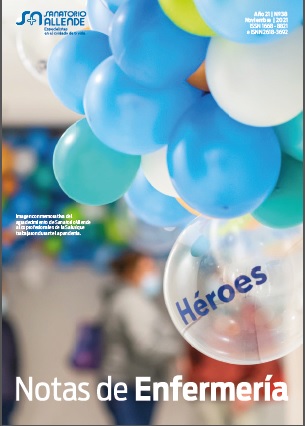Invisible care in critical patients from the perspective of the nursing team
DOI:
https://doi.org/10.59843/2618-3692.v21.n38.35475Keywords:
perception, nursing, invisible care, criticalAbstract
Introduction: it is true that there are care that are clearly visible and in fact are recorded in the nursing records and clinical history. However, there are other care, commonly called invisible care. The latter are actions and care that most of the time are
intangible but that contribute to the welfare and improvement of people, as much or more than the technical and / or delegated actions, directed to the physical / clinical plane of the patient. Objectives: To understand and interpret the invisible nursing care and its importance in the evolution of the critical patient in the Intensive Therapy service of the Alfredo Italo Perrupato Hospital, in the department of San Martín, Mendoza during the month of June 2019. Material and Method: qualitative phenomenological study. The population was given by nurses of the adult intensive care service. Saturation sampling. Open interviews were used in depth. The data was recorded manually and then a detailed analysis of the information was made. An explanatory informed consent was previously given to each respondent. Conclusions: The critical nurse plays a fundamental role during the stay of his patients, since his role involves many more things than just the technical procedures. This relationship requires not only scientific knowledge but also values and ethical care. The nurse is, by consideration, a good therapeutic companion, since he is able to be an educator, have an empathic attitude, exercise active listening, contain stressful situations, provide affection and be faithful to the needs of patients.
Downloads
References
- Huércanos I. Cuidado Invisible: donde los medicamentos no llegan. Mexico.2013.Disponible:http://scielo.isciii.es/scielo.php?script=sci_arttext&pid=S1132-12962013000100001&lng=es.
- De la Rosa E., Zamora Monge G. Cuidados invisibles: ¿son suficientemente reconocidos?México.2012. Disponible:http://scielo.isciii.es/scielo.php?script=sci_arttext&pid=S1132-12962012000300009&lng=es.
- Puga García A., MadiedoAlbolatrach M., Brito Hernández I., Escobar Carmona E. Modelo para desarrollar la Asistenciabilidad en el proceso de formación del profesional de enfermería. EducMedSuper .2010.Disponible en:http://scielo.sld.cu/scielo.php?script=sci_arttext&pid=S0864-21412010000200004&lng=es.
- Stuckey H, Tisdell E. The Role of Creative Expression in Diabetes: An exploration ointo the Meaning-making process. Qual Health Res, 2010; 20(1): 42-56
- Watson J. Nursing Human science and Human Care: A Theory of Nursing. New York: National League of Nursing, 1988.p. 158
- Muñoz Y, Coral R, Moreno D, Pinilla D, Suárez Y. Significado del cuidado humanizado en egresadas de la Facultad de Enfermería. Rev Repertorio de Medicina y Cirugía. 2009; 18(4):246-250. 21.
- Rivera L, .Álvaro T. Cuidado humanizado de enfermería: Visibilizando la teoría y la investigación en la práctica en la clínica del Country. Actual. Enferm. 2007; 10(4):15-21.
- González L, Velandia A, Flores V. Humanización del cuidado de enfermería. De la formación a la práctica clínica. CONAMED. 2009; (14):40-43.
- Huércanos Esparza, Isabel. Cuidado Invisible: donde los medicamentos no llegan. Index de Enfermería 2013; 22(1-2): 5-6.
- Rodríguez-Jiménez S.,Cárdenas-Jiménez M., Pacheco-Arce A. L., Ramírez-Pérez M. Una mirada fenomenológica del cuidado de enfermería. EnfermeríaUniversitaria145-153.2014 .Disponible:http://www.scielo.org.mx/scielo.php?script=sci_arttext&pid=S1665-70632014000400005&lng=es.
- Colliere M. F. Encontrando el sentido original de los cuidados enfermeros. Rev. Tol. Enferm. 1999; 22 (1): 27-31.
- Bustamante, C; Ferreyra, N. Cuidados emocionales que brindan los enfermeros a pacientes quirúrgicos. Notas de enfermería, Sanatorio Allende, vol. 17, pág. 2. 2011
- Olmedo MC, Sanchidrian de Blas C, Pla R, Puentes MD, Rodriguez P. Sistemática para la protocolización del cuidado de enfermería. Revista de calidad-asistencial.2010;268274.Disponible: http://zl.elsevier.es/es/revista/revistacalidad-asistencial-256
- Irrutia P, Villarroel M. Cuidados emocionales que brindan los enfermeros a pacientes quirúrgicos [Internet]. Tunuyán – Mendoza; 2009. [Actualizado 2009;Disponible:http://www.enfermeria.fcm.unc.edu.ar/biblioteca/tesis/irrutia_patricia.pdf
- Gracia Á. Sócrates un filósofo para la enfermería. Madrid; 2014: http://www.secpal.com/%5CDocumentos%5CBlog%5Carchivo_239.pdf
- Rodríguez Sanza , J. et al. Aspectos clave de la comunicación no verbal en la consulta. FMC. 2011;18(7):401-9.
- Sociedad Mexicana de Cardiológica. Editorial: El cuidado de Enfermería. Revista Mexicana de Enfermería Cardiológica 2002;10 (3): 88-89
- José C. Higuera. El poder Terapéutico del Contacto Físico. 2004: https://www.josecarlosbermejo.es/wpcontent/uploads/2018/04/articuloes
- Carmen R. de Larrucea. Derecho y salud no van siempre de la mano. DistanciaTerapéutica.2016:https://carmenrodrigodelarrucea.wordpress.com/2016/01/28/distancia-terapeutica/
- Ghorob A. Health coaching: teaching patients how to fish. FamPractManag. EEUU. 2013;20(3):40-42
- Almeida Rebouças C., FreitagPagliuca M., CavalcantiRodrigues Júnior J., Barbosa Oliveira G., Almeida P.El análisis comparativo de la comunicación no verbal entre enfermero y paciente ciego. Brasil 2015. 24( 3 ): 134-138. Disponible:http://scielo.isciii.es/scielo.php?script=sci_arttext&pid=S1132-12962015000200004&lng=es.
- Prado Solar L., González Reguera M., Paz Gómez N., Romero Borges K.. La teoría Déficit de autocuidado:Dorothea Orem punto de partida para calidad en la atención. Rev. Med. Electron. 2014; 36( 6 ): 835-845. Disponible en: http://scielo.sld.cu/scielo.php?script=sci_arttext&pid=S1684-18242014000600004&lng=es.
- Sanz P., Jurado M., Fernández M. La humanización de los cuidados, la clave de la satisfacción asistencial:hacia el plan de acogida y acompañamiento. Escuela universitaria de enfermería Santa Madrona,España.2009Disponible:http://diposit.ub.edu/dspace/bitstream/2445/21526/1/2009_2.pdf
- Abraham,G.Espiritualidad filosofía y psiquiatría. España. 2016 http://www.webislam.com/articulos/33665espiritualidad_filosofia_y_psiquiatria.html
- Triana Restrepo M. La empatía en la relación enfermera-paciente. av.enferm.2017; 35(2):121-122.Disponible:
http://www.scielo.org.co/scielo.php?script=sci_arttext&pid=S0121-45002017000200121&lng=en. http://dx.doi.org/10.15446/av.enferm.v35n2z
Downloads
Published
How to Cite
Issue
Section
License
Copyright (c) 2021 Sanatorio Allende

This work is licensed under a Creative Commons Attribution-NonCommercial 4.0 International License.
Those authors who have published with this journal, accept the following terms:
- Attribution — You must give appropriate credit, provide a link to the license, and indicate if changes were made. You may do so in any reasonable manner, but not in any way that suggests the licensor endorses you or your use.
- NonCommercial — You may not use the material for commercial purposes.

